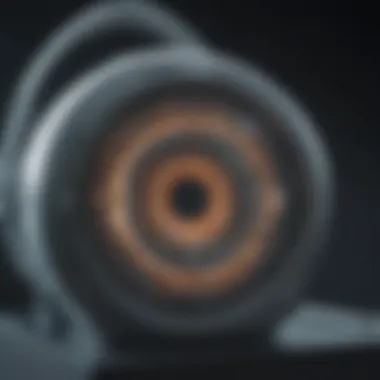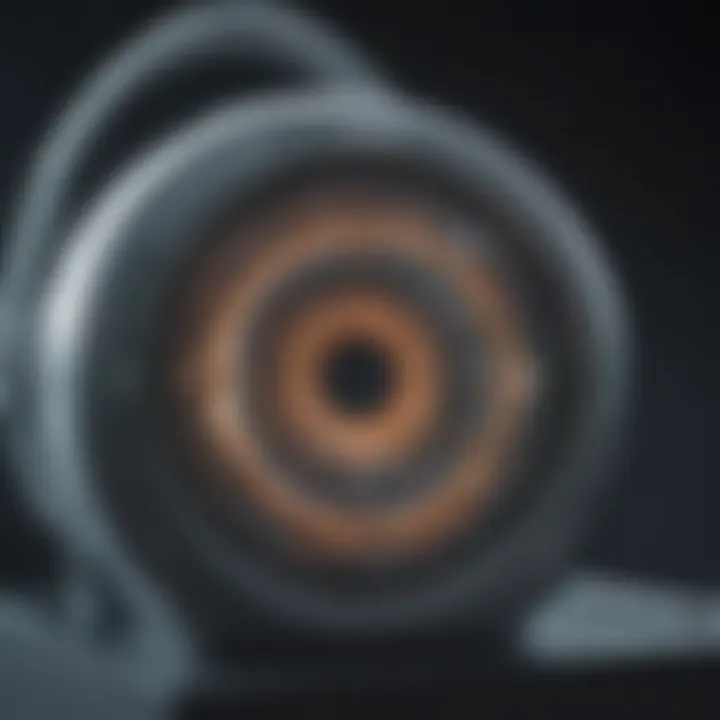MRI for Body: Insights into Applications and Advancements


Intro
Magnetic Resonance Imaging, commonly referred to as MRI, plays an essential role in modern medical diagnostics. Its ability to create detailed images of internal body structures makes it valuable across multiple medical fields. The significance of MRI extends beyond mere imaging; it influences patient management, personalizes care, and represents advancements in medical technology. However, a comprehensive understanding of MRI requires a grasp of its fundamental principles along with an awareness of the various applications and potential future developments.
Key Concepts and Terminology
Definition of Key Terms
MRI operates on the principles of nuclear magnetic resonance. It utilizes strong magnetic fields and radio waves to generate images of organs and tissues within the body. Here are some important terms associated with MRI:
- Magnetic Field: A space around a magnet where magnetic forces can be observed. MRI machines generate a powerful magnetic field.
- Radiofrequency Pulse: These pulses excite hydrogen atoms in the body, allowing for the capture of images.
- Tissue Contrast: Refers to the differences between various types of tissues in magnetic resonance imaging.
- Voxel: A three-dimensional pixel that represents a value on a grid in three-dimensional space. In MRI, voxels help in constructing detailed images.
Concepts Explored in the Article
The article discusses the following key concepts surrounding MRI:
- Applications in Medical Fields: MRI's role in detecting conditions like tumors, brain disorders, and musculoskeletal injuries.
- Technological Advancements: Innovations in MRI such as functional MRI (fMRI) and diffusion tensor imaging (DTI).
- Patient Care Impacts: How MRI findings influence treatment decisions and patient management.
- Safety Considerations: Understanding the safety protocols and concerns associated with the use of MRI.
- Future Trends: Emerging directions in MRI technology and its implications for personalized medicine.
Findings and Discussion
Main Findings
- Diverse Applications: MRI is highly effective for visualizing soft tissues, making it indispensable in neurology, orthopedics, and oncology.
- Technological Enhancements: Increased resolution and faster imaging times are two critical advancements that have been achieved in recent years. Innovations like functional MRI have expanded how physicians understand brain activity.
- Impacts on Patient Care: Effective communication of MRI findings among healthcare providers enhances treatment accuracy. A precise understanding of imaging results can significantly impact patient outcomes.
- Safety Protocols: MRI is considered a safe imaging modality. Risks primarily emerge in patients with metallic implants. Thus, patient screening remains vital.
- In neurology, MRI helps in diagnosing conditions like multiple sclerosis and brain tumors.
- In orthopedics, it is crucial for assessing joint diseases and injuries.
"The fusion of advanced imaging techniques and clinical application presents an unprecedented opportunity for precision medicine in the realm of MRI."
Potential Areas for Future Research
Future research in MRI can focus on:
- Enhancing Imaging Techniques: Investigating new contrast agents and methods to improve image clarity and diagnostic capabilities.
- Integration with Artificial Intelligence: Exploring how AI can assist in interpreting MRI images to enhance diagnostic accuracy.
- MRI-Guided Interventions: Studying the use of MRI in guiding minimally invasive procedures.
- Understanding Long-Term Impacts: Assessing the effects of repeated MRI exposure on human health, particularly in vulnerable populations.
By examining these detailed facets of MRI, the article seeks to provide a well-rounded perspective on its significance in the medical field today.
Prologue to MRI Technology
MRI, or Magnetic Resonance Imaging, serves as a cornerstone in modern medical diagnostics. By utilizing a magnetic field and radio waves, MRI generates detailed images of organs and tissues within the body. This section will outline the definition of MRI technology, delve into its historical context, and underscore its significance in contemporary healthcare.
Definition and Overview
Magnetic Resonance Imaging (MRI) is a non-invasive imaging technique that employs strong magnetic fields and radiofrequency waves. It allows visualization of internal structures, making it essential for diagnosing various medical conditions. Unlike X-rays or CT scans, MRI does not use ionizing radiation, which enhances its safety profile. The primary purpose of MRI is to produce high-resolution images that can help physicians in assessing and diagnosing a range of diseases.
One of the key characteristics of MRI is its ability to provide contrast between different types of soft tissues, which is vital in many medical assessments. This specificity makes MRI particularly effective in identifying abnormalities in the brain, spinal cord, muscles, and joints. Additionally, MRI can be combined with various contrast agents to further improve the quality of images, allowing for more precise evaluations.
Historical Development of MRI
The development of MRI technology began in the 1970s, with the first images produced in 1977 by Dr. Raymond Damadian. His pioneering work demonstrated the potential of MRI to distinguish between healthy and cancerous tissues. This was a significant breakthrough in medical imaging.
Over the next few decades, MRI technology evolved. The introduction of functional MRI (fMRI) in the 1990s provided scientists with an innovative way to visualize brain activities by measuring changes in blood flow. This brought new dimensions to neurological studies and significantly impacted understanding brain disorders.


Moreover, advancements in software and hardware have led to higher-resolution images and faster scan times. Today, MRI is a routine procedure in many healthcare settings, proving invaluable in diagnosing not just cancers, but a wide variety of diseases.
MRI technology is now an essential component of diagnostic imaging, shaping how practitioners understand and treat medical conditions.
Through understanding both the foundational principles and historical progress of MRI, readers can appreciate its impact on medical practice and patient outcomes. The subsequent sections will explore the fundamental physics behind MRI, its numerous applications in various medical fields, advanced techniques, and considerations regarding safety and future trends.
Fundamentals of MRI Physics
Understanding the fundamentals of MRI physics is essential because it forms the backbone of how magnetic resonance imaging operates. It provides insight into the mechanisms that allow for creating detailed images of the human body. An appreciation of these principles enhances the efficacy of MRI as a diagnostic tool and informs professionals about its limitations and advantages.
Magnetic Fields and Resonance
Magnetic fields are at the core of MRI technology. When a patient is positioned within the MRI scanner, they are exposed to a strong magnetic field, typically measuring 1.5 to 3.0 Tesla. This field aligns the protons in the body, primarily those in water molecules, which make up a significant portion of human tissue.
Protons possess angular momentum and, when placed in a magnetic field, undergo resonance. This means they absorb and re-emit energy in specific frequencies. Radiofrequency pulses introduced during the scanning process cause these protons to depart from their equilibrium state. Once the pulse is turned off, the protons relax back to their original alignment, emitting radio waves in the process. The scanner detects these waves, which provide information about the tissue characteristics, leading to the formulation of detailed images.
In practical terms, the strengths of the signals returned will differ across various tissues due to their unique environments. For instance, fat and water possess varying magnetic properties. Understanding these distinctions is crucial, as it allows radiologists and technicians to interpret the images accurately and diagnose conditions effectively.
Contrast Agents in MRI
Contrast agents play a significant role in MRI imaging. These substances are administered to enhance the visibility of internal structures. The most common agent used is gadolinium, a rare earth metal. When injected into the body, gadolinium alters the magnetic properties of nearby protons, providing a clearer image of blood vessels, organs, and tumors.
There are several key considerations regarding the use of contrast agents:
- Patient Safety: While gadolinium is generally safe, monitoring for allergic reactions is essential. Some patients may experience side effects that can vary in severity.
- GFR Levels: Assessing a patient's glomerular filtration rate (GFR) is vital before administering contrast. Acute kidney injury can arise in rare cases, specifically with patients who have pre-existing kidney conditions.
- Differentiation of Pathologies: The use of contrast can significantly enhance MRI's ability to differentiate between various types of tissues or pathologies. It is particularly useful in oncological imaging, where it helps delineate tumors from surrounding healthy tissues.
"The implementation of contrast agents in MRI has revolutionized diagnostic imaging, introducing new dimensions to the evaluation of pathology and patient management."
Applications of MRI in Medicine
Magnetic Resonance Imaging plays a crucial role in the medical field through its diverse applications. Its ability to generate detailed images of soft tissues and organs makes it indispensable for diagnosis and treatment planning. MRI offers critical insights into various medical conditions, enhancing detection rates and improving patient outcomes. Understanding these applications is essential for healthcare professionals, as it guides clinical decisions and optimizes patient care.
Diagnosis of Neurological Disorders
MRI is particularly valuable in diagnosing neurological disorders. Conditions such as multiple sclerosis, stroke, and brain tumors require careful imaging to confirm diagnosis and assess extent. With high-resolution images, radiologists can examine brain structures in detail, identifying abnormalities not visible through other imaging methods. The detection of lesions and the assessment of brain tissue integrity is critical for creating effective treatment plans.
Assessment of Musculoskeletal Conditions
In musculoskeletal medicine, MRI is often the go-to imaging modality for evaluating joint and soft tissue injuries. It provides insights into conditions like ligament tears, cartilage damage, and inflammatory diseases. MRI's non-invasive nature allows for repeated imaging without exposing patients to radiation, making it suitable for monitoring chronic conditions. Utilizing MRI effectively can lead to precise diagnoses, ensuring patients receive the most appropriate therapies.
Cardiovascular Imaging Techniques
MRI also finds extensive use in cardiovascular imaging. Techniques such as cardiac MRI provide essential information about the heart's structure and function. This imaging modality helps in assessing myocardial diseases, congenital heart defects, and evaluating heart function post-intervention. The ability to visualize blood flow and perfusion also aids in diagnosing conditions like coronary artery disease, enhancing the overall management of cardiac patients.
Oncological Applications of MRI
In oncology, MRI is pivotal for tumor detection, characterization, and treatment planning. It offers high-contrast images of tumors, facilitating precise localization and assessment of their extent. This imaging modality is critical in planning surgical interventions or radiotherapy. MRI can also be used to monitor treatment response, making it invaluable in managing patient care throughout their cancer journey. Its role in assessing metastatic disease adds another layer of value in oncological settings.
MRI is vital for accurate diagnosis and effective treatment planning across various medical fields. Its applications span from neurology to oncology, underscoring its significance in contemporary medicine.
Overall, the applications of MRI in medicine underscore its importance as a diagnostic tool that enhances the quality of patient care. Each application in different medical fields highlights the need for further advancements, ensuring that MRI continues to meet the evolving demands of healthcare.
Advanced MRI Techniques


Advanced MRI techniques represent a significant evolution in imaging technology, allowing healthcare professionals to obtain more detailed and functional insights into the human body. As the medical field increasingly embraces precision medicine, these advanced methods play a critical role in diagnosis and treatment planning. Understanding these techniques, which enhance the capabilities of traditional MRI, is essential for students, researchers, and medical professionals.
Functional MRI and Its Impact
Functional MRI, often abbreviated as fMRI, measures brain activity by detecting changes in blood flow. This technique has revolutionized our understanding of neurovascular coupling, where increased neuronal activity leads to increased blood flow to specific brain regions. By mapping brain activity in real time, fMRI provides critical insights into cognitive functions and neurological disorders.
- Applications: fMRI is crucial in pre-surgical planning for brain tumor resections. It helps identify functional areas of the brain, which can be preserved during surgery.
- Research: It also plays a vital role in research surrounding mental health conditions such as depression and anxiety.
“Functional MRI gives researchers and clinicians a real-time view of brain activity, enhancing our understanding of neurological diseases and guiding treatment.”
Diffusion Tensor Imaging
Diffusion Tensor Imaging (DTI) is a specialized form of MRI that maps the diffusion of water molecules in the brain. This technique is particularly useful for visualizing white matter tracts and understanding the brain's microstructural integrity.
- Benefits: DTI assists in diagnosing conditions like multiple sclerosis and traumatic brain injuries by revealing alterations in white matter.
- Methodology: The technique utilizes diffusion-weighted imaging to produce detailed maps that illustrate the orientation and integrity of white matter pathways, enabling better understanding of neurological connections.
Magnetic Resonance Spectroscopy
Magnetic Resonance Spectroscopy (MRS) extends the capabilities of conventional MRI by providing information on the biochemical composition of tissues. It allows for the analysis of metabolic changes in various conditions and can supplement MRI findings.
- Usage: MRS is particularly useful in oncology, where it can differentiate between tumor types and assess their metabolic profiles.
- Analysis: It quantifies metabolites like choline, creatine, and N-acetylaspartate, offering insights into cellular processes that might not be visible through standard imaging techniques.
In summary, advanced MRI techniques provide indispensable tools that enhance diagnostic accuracy and the understanding of complex medical conditions. With ongoing research and development, these methodologies will likely continue to expand their role in both clinical practice and medical research.
Safety and Considerations in MRI Imaging
Safety in Magnetic Resonance Imaging is a critical aspect that ensures both patient and personnel well-being during procedures. Understanding the protocols, contraindications, and risk factors associated with MRI enhances its efficacy and minimizes potential complications. This section focuses on the significance of adhering to safety measures and recognizing specific limitations.
MRI Safety Protocols
MRI safety protocols are designed to safeguard individuals undergoing imaging. These protocols include guidelines that medical practitioners follow to ensure a safe environment. Common safety measures encompass:
- Screening Patients: Before any scan, patients must undergo careful screening. This includes questions about medical history, prior surgeries, and the presence of implants or foreign bodies.
- Magnet Safety Zones: MRI suites can be divided into zones with varying safety levels. Zone I is unrestricted, while Zone IV is the MRI room itself, where strict control is required. Personnel should limit access to Zone IV to only those qualified.
- Emergency Procedures: Medical staff must be well trained in emergency protocols. Familiarity with MRI-specific emergencies, such as equipment malfunctions, is vital.
- Patient Monitoring: Continuous monitoring of the patient during the MRI procedure is essential to detect any discomfort or complications swiftly.
Following these protocols instills confidence and helps in providing high-quality care. Maintaining an organized and safe environment encourages patient compliance and improves outcomes.
Contraindications and Risk Factors
Contraindications and risk factors must be understood by both practitioners and patients prior to an MRI scan. MRI is generally safe, but there are circumstances when it should be avoided or approached with caution.
Some common contraindications include:
- Implants: Patients with pacemakers, cochlear implants, or neurostimulators should avoid MRI due to the magnetic field’s potential interference.
- Metallic Foreign Bodies: Individuals with shrapnel or metal fragments in the body, especially near the eyes, may face serious risks during an MRI.
- Severe Claustrophobia: Patients who experience intense anxiety in confined spaces often require sedation or alternative imaging methods.
- Pregnancy: Although MRI is typically safe in pregnancy, it should be used judiciously, especially in the first trimester.
"Understanding the contraindications can prevent adverse events, safeguarding both the patient and the clinical team.”
Risk factors can include renal insufficiency when using contrast agents.
In summary, MRI safety and considerations are essential components that optimize the imaging experience. Proper adherence to protocols and awareness of contraindications play a significant role in ensuring safety. This allows healthcare providers to deliver precise diagnostics while maintaining a focus on patient care.
Future Trends in MRI Technology
The field of MRI technology is on the brink of significant transformation. As medical science advances, so too does the need for imaging techniques that provide more detailed, quicker, and safer examinations. Future trends in MRI are pivotal to enhancing diagnostic capabilities and improving patient outcomes.


One important aspect to consider is the development of advanced imaging techniques. These new methodologies aim to reduce scan times and improve image quality, thus addressing some of the limitations of traditional MRI. By leveraging innovations like ultrafast imaging sequences, practitioners can obtain high-resolution images in a shorter duration.
Moreover, investments in scanner technology promise a shift towards more powerful magnets, leading to improved signal-to-noise ratios. This enhancement will yield clearer imaging, essential for accurate diagnostics. The integration of lighter and more portable MRI machines may also revolutionize the availability of these services, especially in remote locations.
Another critical element involves the incorporation of software advancements that automate and enhance the imaging process. This includes automatic image analysis and improved software for visualization, which can assist radiologists in diagnosing conditions more efficiently.
Emerging Techniques and Innovations
Emerging techniques are setting a new standard in MRI practices. Among these innovations is the use of compressed sensing. This methodology allows for the acquisition of high-quality images in significantly reduced time. As a result, patients experience less discomfort during lengthy scans, and the workflow for medical facilities becomes more streamlined.
Additionally, researchers are exploring three-dimensional imaging. This technique offers intricate details of anatomical structures, which is particularly beneficial for surgical planning or complex diagnostic cases. Furthermore, real-time MRI, a technology that provides immediate feedback during imaging, is gaining traction, especially in interventional procedures.
Integration of AI and Machine Learning
The integration of artificial intelligence and machine learning into MRI technology marks a revolutionary step forward. AI algorithms can analyze large datasets to identify patterns indicative of various conditions, thereby facilitating quicker and more accurate diagnoses. These technologies not only enhance image interpretation but can also predict patient outcomes based on imaging data.
AI also plays a vital role in workflow optimization. By assessing image quality and automating certain processes, these tools help in minimizing human error and reducing the workload on radiologists. In this way, AI fosters an environment where healthcare professionals can focus on critical tasks that require human expertise.
MRI and Personalized Medicine
Personalized medicine refers to the tailoring of medical treatment to the individual characteristics of each patient. This approach is increasingly relevant in the realm of Magnetic Resonance Imaging (MRI). The integration of MRI into personalized medicine allows for precise diagnostics and treatment planning, enhancing patient care. MRI offers benefits such as non-invasive imaging, high-resolution detail of anatomy, and valuable insights regarding functional processes.
The concept of personalizing MRI protocols involves adapting the imaging process based on specific patient conditions, genetic factors, and the clinical context. This method leads to improved accuracy in diagnosis and effective monitoring of treatment outcomes.
"Personalized medicine represents a shift from a one-size-fits-all approach to more tailored treatment strategies, making MRI a cornerstone in this evolution of clinical practice."
Tailoring MRI Protocols for Patient Needs
Tailoring MRI protocols means adjusting the imaging technique based on the specific needs of each patient. Several factors influence these adjustments, including:
- Medical history: Understanding a patient's previous health issues informs the MRI approach. For instance, a patient with a history of claustrophobia may require an open MRI design.
- Clinical questions: The type of injury or condition determines the imaging specifics. For instance, a spinal cord injury might require a different sequence than a brain tumor.
- Physiological aspects: Factors like age, body size, or presence of implants influence the choice of contrast agents and imaging parameters.
These considerations expand the effectiveness of imaging. A personalized approach increases the likelihood of obtaining the necessary information to guide treatment decisions, ultimately leading to better patient outcomes.
Case Studies and Outcomes
Multiple case studies highlight the success of using personalized MRI strategies. One notable example is the management of brain tumors. In one scenario, a patient with a rare tumor type underwent a specialized MRI protocol designed specifically for his condition. This tailored approach provided critical information about the tumor's vascular characteristics and its relationship to surrounding tissues. As a result, the surgical team could plan a more effective and minimally invasive procedure.
Additionally, pediatric cases often demonstrate the importance of personalized MRI. Children might have different physiological responses and developmental considerations compared to adults. Adapting protocols, such as using lower radiation doses or sedation where necessary, ensures safer and more effective imaging in this population.
The positive outcomes from these cases underscore the impact of personalized MRI on enhancing diagnostic accuracy, optimizing treatment paths, and improving overall patient satisfaction.
Finale
The conclusion section of this article encapsulates the essence of Magnetic Resonance Imaging (MRI) in contemporary medical practices. MRI has fundamentally transformed diagnostic imaging, enabling healthcare professionals to visualize internal structures non-invasively with remarkable clarity. By summarizing the key insights presented, this segment emphasizes the multifaceted role that MRI plays in modern medicine.
Summary of Key Points
- MRI's technological advances have enhanced imaging capabilities, providing superior resolutions than traditional methods.
- Diverse applications in neurology, oncology, and musculoskeletal diagnostics are explored. These applications illustrate MRI's versatility in addressing various health concerns.
- Safety protocols and patient considerations are crucial. Adhering to these guidelines ensures optimal outcomes and minimizes risks associated with MRI procedures.
- The integration of emerging technologies, especially in personalized medicine, showcases how MRI adapts to unique patient needs, enhancing treatment effectiveness.
The depth and breadth of MRI applications highlight its critical role in diagnosing and monitoring health conditions. With ongoing advancements, MRI continues to improve patient outcomes, providing invaluable data that aids in decision-making for healthcare providers.
Final Thoughts on MRI’s Role in Medicine
As the medical field evolves, so does MRI's role. It serves not just as a diagnostic tool but as a pivotal component in personalized medicine approaches. A patient-centered model now allows for tailored MRI protocols that reflect individual conditions and treatment responses. This precision aligns with contemporary values of improved patient care and outcomes.
Moreover, the advancements in artificial intelligence and machine learning integration with MRI technology promise to further refine diagnostic accuracy and efficiency. This shift represents a significant step towards more effective healthcare delivery.
In summary, MRI stands as a cornerstone of modern medical imaging, poised for continued evolution and growth. Its benefits extend far beyond imaging, impacting patient management and treatment pathways profoundly. As research progresses and technology advances, the future of MRI in medicine looks incredibly promising.







